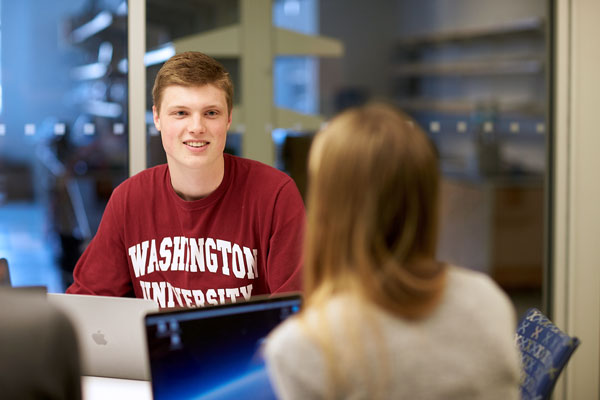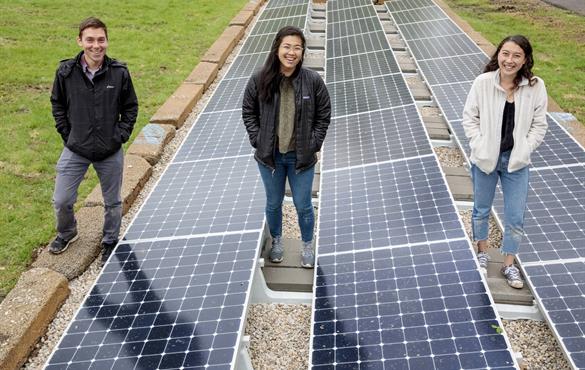It's easy to start your application.
Undergraduate Programs
Undergraduate Research

Curious about academic research? Gain experience in world-class ESE labs as an undergraduate researcher working with accomplished faculty:
- Not sure if you're interested in research? Consider ESE 2991 Research Experience in ESE, a 1-unit course designed to expose you to ESE research.
- Ready for more experience? Consider ESE 2992 Introduction to Research in ESE, 2 units of introductory mentored research.
- Already have a prospective advisor and/or project? ESE 4991 Undergraduate Research, 1-3 units to work on an independent research project and present it at an ESE research symposium.
- Envision research as an integral part of your future career? Plan for ESE 4992 Honors Thesis Research.
- Want to get experience outside the classroom and to work closely with members of the ESE faculty? Consider ESE 4999 independent study.
Students must complete the ESE Undergraduate Research/Independent Study Approval Form in order to enroll in any research or independent study course.
To help decide which experience is right for you, review the Department of Electrical & Systems Engineering research areas, as well as the focus areas of department faculty, to learn more about our strengths and research activities. You're invited to contact individual faculty members to inquire about research in their labs.
Students can also review the research projects that are currently available in faculty research labs listed below.
Beyond the department, you can take part in a number of research opportunities at the school and university level, including the Washington University Summer Fellowship Program (WUSEF), which provides exceptional students from backgrounds underrepresented in the STEM fields, including underrepresented minority students, students from economically disadvantaged and underserved backgrounds and students with disabilities, a chance to perform research at institutions throughout the country, as well as resources and options available through the Office of Undergraduate Research.
To register for any undergraduate research course, your project must be approved and supervised by an ESE faculty member. Complete the appropriate form (see sidebar) and submit to the ESE office with signatures from your research project faculty advisor and your academic faculty advisor.

A trio of Electrical & Systems Engineering students helped expand the solar power generating capabilities at Tyson Research Center as part of an independent study course.
Current Research Projects
Students who aren't sure what type of research they'd like to perform or need inspiration as to what research projects are available are encouraged to review the list of currently available research opportunities below.
Applied Physics
Shantanu Chakrabartty
Emulating a million neuron-brain in real time
- The goal of this project is to leverage advances in GPU-based and conventional computing platforms to simulate a synthetic biological brain comprising of more than a million connected neurons in real time.
- The design will be based on a specific model of a neuron that has been developed in AIMLab which enables the end user to create large-scale and stable neuro-dynamical system and also allows the user to experiment with different types of network-level dynamics. For this project, the student team will leverage a previously developed MATLAB toolbox to scale the user and visualization interface to support the construction and analysis of a million neuron system in real time.
- As a case study, the software will be used to construct a complete insect brain where the user can define the structure and connectivity of the network, along with different types of neurons.
- Suggested background: MATLAB, signal/image processing, basic neuroscience or neural network (optional)
Matthew Lew
Imaging DNA nanostructures and nanomachines using single-molecule, super-resolution microscopy
- Synthetic DNA nanostructures (i.e., DNA origami) are useful for a variety of applications in drug delivery, nanotechnology, and biophysics. In this project, the student will learn how to design and synthesize 3D DNA origami, how to design and build a chamber to actuate the origami, and how to image the position and conformation of the DNA using imaging technology in the Lew Lab. The specific project details are flexible and will be refined based on student experience and interest.
- Desired academic major: Flexible, and can include biomedical engineering, chemistry, chemical engineering, electrical engineering, or physics
- Suggested background/courses: Flexible, but a strong applicant will have experience in some of the following: Fluorescence microscopy, electromagnetics, applied/modern optics, Fourier transforms, linear systems, statistical signal processing, molecular biology
- Photons, the fundamental packets of light, can carry a wealth of information about a specimen of interest using their various degrees of freedom, including position, propagation direction, polarization, wavelength (energy), and time of arrival. In this project, the student will learn how to design and construct a photomultiplier-tube based ultrafast camera, capable of measuring the position and time of arrival of single photons (~500 ps resolution). The student will also design and test ultrafast readout electronics (~500 MHz sampling rate) for measuring these parameters and streaming them to a computer over gigabit ethernet. The specific project details are flexible and will be refined based on student experience and interest.
- Desired academic major: Flexible, and can include electrical engineering, computer engineering, or physics
- Suggested background/courses: Flexible, but a strong applicant will have experience in some of the following: Electromagnetics, applied/modern optics, Fourier transforms, linear systems, statistical signal processing, digital logic, digital/embedded systems
Systems Science
Shen Zeng
- Stabilization and active maneuvering of nonlinear dynamical systems in an optimized way (e.g., by minimizing energy consumption) are critical tasks of fundamental importance in various engineering problems. In this project, students can learn about modern data-integrated and learning-based approaches developed in the lab for synthesizing such optimal control laws for nonlinear systems and are also given the opportunity to apply these to different system models (including both simulations and physical implementations, such as quadcopters and other robotic systems).
- Suggested background/courses: a solid understanding of basic control systems principles (ESE 441), experience with Matlab programming
Devices & Circuits
Chuan Wang
- Soft electronic devices built on ultrathin elastic substrates are suitable for a wide range of applications such as wearable devices and soft robotics. Our group has formulated various types of nanomaterial- and polymer-based electronic inks that can be patterned with high resolution and uniformity using a low-cost printing process. In this project, the students will learn how to fabricate stretchable electrode array and sensors (pressure, strain, temperature) using inkjet printing and characterize the sensor response curve. The student may also work on microcontroller board programming to allow the data from the sensors to be wirelessly transmitted to a smartphone app. Combining the above, a soft sensor patch will be prototyped and its functionality will be validated by using it to collect signals including heart rate, body temperature, and biopotential.
- Suggested background/courses: Analog and digital circuits, semiconductor devices, Arduino microcontroller board or Raspberry Pi.
Develop printed stretchable perovskite light-emitting diodes
- Flexible or stretchable displays have attracted a significant amount of interest recently in the consumer electronics market. The key components in such displays are organic or polymer light-emitting diodes (LEDs) built on plastic or elastic substrates. In the project, the student will work on formulating inks comprising perovskite nanocrystals dispersed in a conductive polymer. The ink will subsequently be used to fabricate stretchable LEDs using a low-cost inkjet printing process. The research aims to demonstrate LED devices that can be repeatedly stretched by at least 50% without reducing brightness. Once the printed LEDs are successfully demonstrated, they will be integrated to form a passive-matrix stretchable display.
- Suggested background/courses: Chemistry, materials science, semiconductor devices
